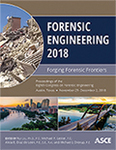Eighth Congress on Forensic Engineering
Introducing New Framework to Capture Extreme Uncertainty in Risk Management of Landslides
Publication: Forensic Engineering 2018: Forging Forensic Frontiers
ABSTRACT
Landslide is a complicated multi-hazard event that can turn into a great disaster; burying part of a city or village downhill the slope and causing a large number of fatalities. Landslide risk assessment and management (LRAM) process involves decision making to find an optimal loss-mitigation approach. A good, representative decision analysis process relies on reasonably capturing all possible scenarios that would happen in a landslide event and assessing the probabilities. This requirement for the evaluation of possible scenarios exists while there are multiple sources of uncertainties in such a problem and our knowledge of extreme events is limited. In our research, we showed that using the historical data and extending past knowledge to predict a future event is not completely applicable and reliable. Thus, it is important to consider the possibility of irrelevancy of historical data to the problem. The research shows that to consider extreme and rare events, it is required to use a non-informative prior probability in the Bayesian analysis. Such non-informative prior probability distribution is obtained by maximizing the entropy of possible events, which maximizes the lack of information. This paper includes a summary of our research to develop a new decision-based framework in order to reasonably capture sources of uncertainties in the landslide risk management decision analysis. In addition, a practical example of application of the framework to a landslide case study will be presented.
Get full access to this article
View all available purchase options and get full access to this chapter.
References
AGS. (2000). Landslide risk management concepts and guidelines. Australian Geomechanics Society, 35(1), 51-92.
ANCOLD. (1996). Commentary on ANCOLD guidelines on risk assessment Sydney, Australia: Australian National Committee on Large Dams.
Ang, A. H., & Tang, W. H. (1984). Probability Concepts in Engineering, Planning & Design, V. II : Decision, Risk and Reliability. John Wiley & Sons.
Blikra, L. H., Longva, O., Braathen, A., Anda, E., Dehls, J. F., & Stalsberg, K. (2006). Rock-slope failures in Norwegian fjord areas examples, spatial distribution and temporal pattern. In S. G. Evans, G. S. Mugnozza, A. Strom, & R. L. Hermanns, Landslides from Massive Rock Slope Failure (pp.475-496). Netherlands: Springer.
Cave, P. W. (1992). Natural hazards, risk assessment and landuse planning in British Columbia : Progress and problems. First Canadian Symposium on Geotechnique and Natural Hazards, (pp.1-12).
Dai, F. C., & Lee, C. F. (2001). Frequency±volume relation and prediction of rainfall-induced landslides. Engineering Geology 59, (pp.253-266).
Eidsvig, U. M., Medina-Cetina, Z., Kveldsvik, V., Glimsdal, S., Harbitz, C. B., & Sandersen, F. (2011). Risk assessment of a tsunamigenic rockslide at A°knes. Natural Hazard, V. 56, (pp.529-545).
Gilbert, R. B., Habibi, M., & Nadim, F. (2016). Accounting for Unknown Unknowns in Managing Multi-Hazard Risks. In P. Gardoni, & J. M. LaFave, Multi-hazard Approaches to Civil Infrastructure Engineering (pp.383-412). Springer International Publishing Switzerland.
Guzzetti, F., Malamud, B. D., Turcotte, D. L., & Reichenbach, P. (2002). Power-law correlations of landslide areas in central Italy. Earth and Planetary Science Letters 195, (pp.169-183).
Hong Kong Planning Standards and Guidelines. (1993). Hong Kong Government Planning Department.
Hungr, O., Evans, S. G., & Hazzard, J. (1999). Magnitude and frequency of rockfalls and rockslides along the main transportation corridors of southwestern British Columbia. Canadian Geotechnical Journal, 36, (pp.224-238).
Keaton, J. R., Wartman, J., Anderson, S., Benoit, J., deLaChapelle, J., Gilbert, R. B., & Montgomery, D. R. (2014). The 22 March 2014 Oso Landslide, Snohomish County, Washington. Geotechnical Extreme Events Reconnaissance (GEER), National Science Foundation.
Wise, M. P., Moore, G. D., & VanDine, D. F. (2004). Landslides Case Studies in Forest Development Planning and Operations, Land Management Handbook No. 56. Victoria, B.C.: British Columbia Ministry of Forests.
Information & Authors
Information
Published In
Forensic Engineering 2018: Forging Forensic Frontiers
Pages: 235 - 247
Editors: Rui Liu, Ph.D., Kent State University, Michael P. Lester, Element Analytical, Alicia E. Díaz de León, and Michael J. Drerup
ISBN (Online): 978-0-7844-8201-8
Copyright
© 2018 American Society of Civil Engineers.
History
Published online: Nov 27, 2018
Authors
Metrics & Citations
Metrics
Citations
Download citation
If you have the appropriate software installed, you can download article citation data to the citation manager of your choice. Simply select your manager software from the list below and click Download.
